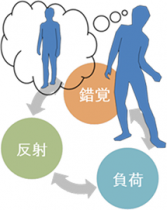Development of hemiplegic gait simulation tools for educational purposes
2012-0319-01

- researcher's name
-
about researcher UESUGI, Shigeru Professor
- affiliation
-
Faculty of Science and Engineering School of Creative Science and Engineering
- research field
-
Intelligent mechanics/Mechanical systems
- keyword
-
background
Hemiplegia simulation training is being undertaken at educational institutions for physical therapists and nurses in order to deepen trainee understanding of people with hemiplegia. However, it has been pointed out that current simulation tools only endow trainees with an indirect burden of being fixed and unable to move, and that this is not sufficient as a simulation experience.
summary
This project is drawing attention to the gaps between movement and sensation experienced by those with hemiplegia, such as the feeling of being unable to move even though the patient wants to move the body parts, or the feeling that body parts are moving on their own. The project is developing methods to allow those in good health to experience such subjective sensations in a non-invasive and safe way.
application/development
●Based on four development guidelines, the project investigates test systems and tests out simulation tools (production devices).
●Publication of simulation design: In addition to training physical trainers and nurses and so on, the project aims to development simulation tools that can spread through society by running a variety of tests among the general public as well by opening web events and simulations and workshops.
●By proposing effective simulation experiences for designers and engineers involved in universal design, the project will support the development of new products.
predominance
By combining the three movement types of the sense of motion, reflexive motion, and load regulation through a subsultus movement stimulation method developed by this project, the project will make it possible to simulate and experience gaps between movement and sensation.
Up until now, this has been communicated through subjective images and physical experiences.
This project is researching design principles for tools to support the creation of new physical expressions, and as such, it will also be able to work on initiatives for rehabilitation support based on the perspective of fields such as cognitive neuroscience.
purpose of providing seeds
Sponsord research, Collaboration research, Technical consultation
material
posted:
2014/05/21

